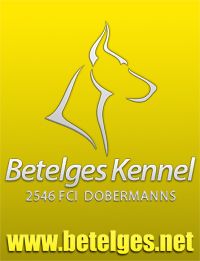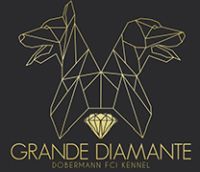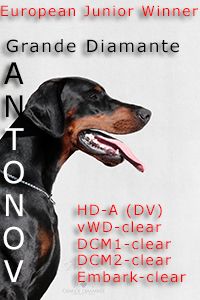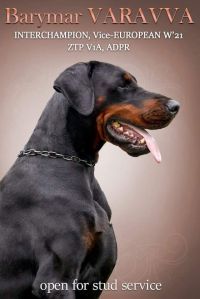Autori:
Dr. Massimo Massa
Giudice specialista Dobermann
DVM dottore in medicina veterinaria
Allevatore – Dobermann Kennel Dell'Urbe – dal 1970
Dr. Angelo Magnifico
Giudice specialista Dobermann
DVM dottore in medicina veterinaria
Allevatore – Dobermann Kennel del Canale di Pirro – dal 1973
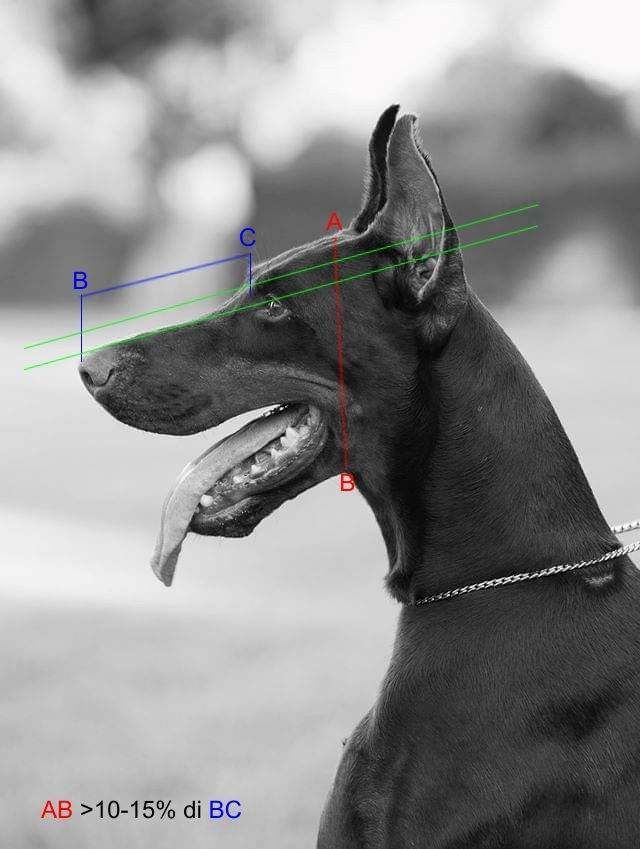
Queste poche righe, sono il frutto di innumerevoli dialoghi e scambi di opinioni avuti negli ultimi anni, tra vecchi conoscitori della razza e alcuni neofiti dobermanisti.
Questi amichevoli confronti tecnici, mi hanno permesso di comprendere che negli ultimi tempi si sia creata un po' di confusione su come deve, o non deve essere la testa del Dobermann.
Senza voler fare della filosofia, credo che si sia venuto a creare un dualismo di pensiero, una sorta di inconciliabile principio che divide due fazioni opposte.
La cinognostica, pur non essendo una scienza esatta, non dovrebbe dar luogo a dualismi, in quanto la stessa si basa su parametri ben definiti e descritti in maniera chiara ed inequivocabile dagli standard di razza. Pertanto la stessa al contrario, dovrebbe viaggiare su linee parallele, esattamente come gli assi cranio facciali del Dobermann o come i binari di un treno, per indirizzare e portare la nostra razza in una destinazione unica e certa.
Troppo spesso su internet vediamo post e foto di teste assolutamente fuori tipo a cui seguono centinaia di Like e pareri entusiastici.Tra l'altro questi soggetti, in alcune nazioni europee, vincono incomprensibilmente expò e campionati. Cani che hanno pochissimo del Dobermann, anzi, purtroppo molto spesso hanno caratteristiche di altre razze. Assi cranio facciali spesso divergenti o a volte convergenti, musi esageratamente forti tipici di razze molossoidi, crani rotondi, rughe sulla fronte, labbra abbondanti e pendule, pelle spessa, occhi tondi e infossati con nessuna espressione di razza. Tutto ciò mi sorprende, e mi fa pensare che si stia snaturando e trasformando in modo involutivo la nostra razza. Credo sia necessario porre rimedio a questa grande confusione nell'interpretazione dello standard, e a tal fine insieme al Dr. Massimo Massa, giudice FCI specialista di razza e allevatore di Dobermann da quasi cinquant'anni, abbiamo pensato di scrivere qualcosa in merito per dare qualche indicazione tecnica. Per avere un futuro certo, bisogna avere radici forti da cui partire. Non si puo' conoscere e comprendere una razza senza aver visto le qualità di tipo dei von Furstenfeld, dei von Forrell, dei von Franckenhorst, dei von Hagestern, dei Von Norden Stamm etc... Credo sia consigliabile a tutti i neofiti della razza, di leggere e studiare i vecchi libri sul Dobernann ed in particolare soffermarsi attentamente sull'aspetto cinognostico di tali testi. Senza cultura cinotecnica, non si può conoscere e allevare una razza.
Inoltre credo sia utile fare chiarezza ricordando i parametri e le principali caratteristiche della testa, al fine di trovare una linea guida, un' idea comune di come deve essere questa importante macro regione del cane.
Caratteristiche e principali parametri della testa del Dobermann:
Le caratteristiche della testa rappresentano l'indice principale della razza.
La testa del Dobermann è dolicocefala, ossia la sua larghezza bizigomatica deve essere inferiore alla metà della lunghezza totale della testa. In altre parole deve essere stretta e allungata.
Vista dall'alto, la testa ha la forma di un cono tronco e allungato.
Il rapporto cranio – muso è di 1:1 ossia muso e cranio hanno la stessa lunghezza. Queste due macro regioni (cranio e muso) sono divise da una linea ideale orizzontale che unisce le commessure palpebrali mediali, ossia una linea che unisce gli angoli interni degli occhi.
Rispetto ai profili, la testa del Dobermann è rettilinea.
Gli assi cranio - facciali sono paralleli.
Questi due assi non si incontrano mai tra loro.
L'asse inferiore segue il profilo superiore della canna nasale, dalla punta del tartufo fino alla linea retta ideale che unisce gli angoli interni degli occhi. Mentre l'asse superiore è dato da una linea immaginaria longitudinale che unisce due punti di repere ben precisi :
il punto craniometrico nasion e il punto craniometrico inion.

Il punto craniometrico nasion è il punto d'incontro delle apofisi delle ossa nasali, frontali e mascellali superiori.
Questo punto craniometrico nel Dobermann si trova anatomicamente circa alla metà dell' altezza dello stop, ed è inserito superiormente alla linea che unisce gli angoli mediali degli occhi. Purtroppo però, in alcuni scritti di cinofilia e cinognostica si legge che il nasion si trova al centro della retta immaginaria che unisce gli angoli interni degli occhi. Ciò non può essere possibile,se cosi fosse, tutti i Dobermann sarebbero convergenti !

Il punto craniometrico inion corrisponde al centro della squama dell'osso occipitale.
Ricordiamo che i difetti dell'andamento degli assi cranio facciali, ossia divergenza e convergenza, nel Dobermann sono gravi difetti di tipo, che vanno penalizzati in modo incisivo durante le manifestazioni zootecniche.
Altro parametro cinognostico importante è lo stop o salto naso frontale, che corrisponde all'interruzione delle due linee superiori della testa, ossia il profilo della canna nasale e il profilo superiore del cranio. Deve essere ben evidente, ma mai eccessivo. Lo standard recita: lo stop deve essere poco sviluppato, ma perfettamente percettibile.Troppo spesso vediamo degli stop esagerati, scalini, o al contrario stop sfuggenti, quasi impercettibili, che si allontanano fortemente dalla descrizione dello standard.
La canna nasale deve essere rettilinea, larga, ma in proporzione al resto della testa.
Il tartufo deve essere ben sviluppato, largo e di colore nero nei soggetti nero focati e marrone scuro nei soggetti marroni focati.
Le narici devono essere ben aperte.
Il muso deve essere lungo, pieno, ben modellato, deve presentare buoni volumi, ma non deve mai essere eccessivamente forte. Deve essere armonico e proporzionato al resto della testa. Le facce laterali del muso devono convergere moderatamente verso il tartufo. La faccia anteriore del muso deve essere piatta e mai a punta.
La mandibola deve essere lunga e proporzionatamente larga, in modo da dare un volume pieno e armonico al muso. Anteriormente deve raggiungere la mascella in modo da far aderire perfettamente gli incisivi e avere una corretta chiusura a forbice. Soggetti con mandibole profonde, quasi sempre hanno dentature corrette e perfettamente a forbice.
I 42 denti devono essere bianchi, forti, ben allineati e devono chiudere a forbice.
Le labbra sono tese e ben pigmentate. I pigmenti scuri nel Dobermann sono ricercati e rappresentano un pregio. Molto spesso soggetti con colore del mantello nero intenso, con labbra scure e rime palpebrali ben pigmentate, di solito sono accompagnati da occhi di colore scuro. La commessura labiale deve essere visibile ma mai eccessiva. La posizione della commessura dev'essere il più possibile aborale, cioè con rima buccale lunga. Dovrebbe arrivare almeno in linea con l'altezza dell'occhio, meglio se oltre.
Il cranio visto di lato o davanti è piatto. La linea trasversale dell'occipite, vista dal davanti, deve essere orizzontale, pertanto la protuberanza occipitalre esterna non dev'essere molto marcata. I muscoli fronto - parietali devono essere visibili ma non troppo sviluppati. Sulla regione frontale, la sutura metopica dev'essere visibile, ma non troppo marcata. Le arcate sopraccigliari evidenti, ma mai troppo rilevate. Le bozze frontali non sono ammesse nel Dobermann adulto, ma tollerate nel cucciolo in via di sviluppo e durante l'evoluzione delle ossa craniche.
Caratteristica di distinzione di razza è il cesello, è un pregio che riguarda la regione sottorbitale. Esso evidenzia le salienze della regione stessa. Parleremo di ottimo cesello, quando avremo finezza della pelle, poco sviluppo del tessuto sottocutaneo e dei muscoli sottostanti, in modo da percepire visivamente le salienze ossee. Quando la regione sottorbitale risulta non ben cesellata, in cinognostica si usa il termine : testa impastata o cesello impastato.
Oltre all'altezza del muso, un'altro parametro cinotecnico importante è l'altezza della porzione posteriore testa. I punti di repere per valutare tale parametro sono: un punto che parte dal profilo superiore del cranio vicino all'inserzione mediale dell'orecchio e il processo angolare della mandibola. Questo parametro zoognostico si puo' valutare tirando una linea verticale immaginaria che unisce i punti di repere su elencati. Lo strumento cinometrico addatto a questa misurazione è il compasso o nonio, ma un giudice ben allenato potrebbe valutarlo ad occhio senza alcuna difficoltà. L'altezza della testa dovrebbe essere non superiore al 10-15% della metà della lunghezza totale della testa. Pertanto un soggetto con una testa lunga 30 centimetri, avrà il cranio e la canna nasale di una lunghezza pari a 15 centimetri. L'altezza della sua testa sarà massimo di 17,25 centimetri, ovvero il 15% in più della lunghezza nasale o craniale..Una testa molto alta, renderebbe meno armonica la stessa, sarebbe più tozza e avrebbe una forma di parallelepipedo e non tronco conica come richiede lo standard.
L'occhio del Dobermann è di grandezza media e di forma ovale. La sua posizione deve essere semilaterale, con un' inclinazione del 15-25 % della linea che congiunge i due angoli palpebrali rispetto al piano mediano. Sia l'iride che la pupilla devono essere di colore più scuro possibile, ovviamente in rapporto alla varietà del mantello. Gli occhi non devono essere troppo sporgenti o infossati. Sia le palpebre che la nictitante ( terza palpebra) devono essere ben pigmentate, possibilmente dello stesso colore del mantello.
Le orecchie devono essere integre, di forma triangolare, piatte, inserite alte, aderenti alle guance. Le cartilagini auricolari e la pelle devono essere sottili. Devono essere pendenti e mai accartocciate. La loro lunghezza non dovrebbe superare l'altezza della commessura labiale o la metà della lunghezza della testa.
Spero che queste poche righe siano state utili e facilmente fruibili, e abbiano fatto un po' di chiarezza su questo non facile argomento.
Dr. Angelo Magnifico
Insieme all'amico Dottor Angelo Magnifico, entrambi giudici specialisti di razza, abbiamo ritenuto di fare il punto sulla attuale selezione della testa del Dobermann. Abbiamo preso in considerazione la testa che è senza dubbio la regione anatomica che determina l'appartenenza ad una razza in tutte le specie animali. Ma la vera ragione di questa scelta è che spesso vediamo teste assolutamente fuori tipo che vengono addirittura esaltate. Pertanto, abbiamo ritenuto di poter dare qualche indicazione, al fine di fare un po' dichiarezza su tale argomento. E' anche vero però, che rispetto ad altre regioni,selezionare teste più possibile aderenti allo standard non è compito facile, in quanto molti sono i parametri da prendere in considerazione: la lunghezza della testa, il rapporto cranio muso, il parallelismo , lo stop, la lunghezza e i volumi di muso e mandibola, il cesello, l'occhio, l'espressione di razza ecc... .
Dr. Massimo Massa
Post Scriptum:
Ci sarebbe piaciuto corredare questo lavoro con foto e descrizioni tecniche, che tra l'altro erano presenti nella versione integrale dell'articolo, ma ciò non è stato possibile per motivi tecnici. Non era nostra intenzione ledere l'immagine di cani o allevatori. Avevamo scelto foto presenti liberamente nel Web , e come avete potuto notare, volutamente non abbiamo aggiunto nomi di cani, di allevatori o proprietari al fine di non ledere l'immagine di nessuno.
Le foto avevano una funzione esempificativa, per rendere più chiaro e fruibile l'argomento di cui parlavamo in forma scritta. Il nostro unico scopo era, ed è quello di dare un piccolo contributo alla razza, cercando di elargire qualche indicazione su come deve essere la testa del Dobermann seguendo i dettami dello standard. Ovviamente non potevano mancare, al fine di una migliore comprensione, alcuni commenti e alcune considerazioni.
Inoltre, questo articolo è stato scritto esclusivamente dai sottoscritti, senza l'ausilio di nessun altro. E' frutto del libero pensiero di due amatori del Dobermann della vecchia generazione.
Questo piccolo chiarimento ci sembrava doveroso.
Certi della vostra comprensione, vi auguriamo una serena estate.
Viva il Dobermann.
Angelo Magnifico - Massimo Massa
ENGLISH

This short text is a result of many discussions and exchange of views which I observed last years between dobermann experts and some new-comers.
Their friendly technical comparisons between dgogs allowed me to understand that recently some kind of confusion was born in relation to what the dobermann head should be like. It's not my intention to dive deeply into philosophy, I simply believe that specific dualism was created in the way of thinking, sort of internally contrary rule that divides two groups which remain opposite to each other and represent different views on dobermann head.
Cynology is not a scientific subject and shouldn't be as scource to generate dualisms. It is based on clearly defined parameters and characterstics described in breeds standard. Its purpose [standard] was to navigate us and show directions how to develop the breed same as axles of dobermann cranium or railways lead us to one and precise goal. Too often we see in social media photos of dobermann heads which are absolutelly out of type (untypical) but they gain plenty of likes and positive reactions. Such dogs in some european countries incomprehensibly receive awards at dog-shows and other competitions but in fact they have a very small amount of dobermann features [typicity]. What's more, I dare to say that they possess features of other breeds.
As popular defects the following can be mentioned: unparallel lines of head or even opposite, over-massive upper-jaws which are typical for moloses, round skulls, wrinkles on foreheads, thick and free lips, thick skin, round and deeply settled eyes without typical breed expression. It all together trully shocks me and makes me feel like we are in the center of the process where the breed is moving out from its nature and turns into different breed. I find it necessary to take a voice on this issue and along with Dr. Massimo Massa, FCI judge, breed specialist and breeder with 50 years of experience, we came on idea for this article.
The main purpose is to give technical tips for those who were unlucky or due to their age had no chance to discover typical dobermanns.
To have a future, there has to be strong foundation for growth. We can't understand the breed as it is today without looking at possitive aspects of dogs from von Furstenfeld, von Forell, von Franckenhorst, von Hagenstern, von Norden Stamm and other kennels. I do believe that all new-comers of our breed should read and study the history of the breed with strong emphasis on cynological aspects [typicity]. There is no future to develop the breed without respect of cynological culture. Definitely, there's a need to get things in order and remind about essential technical head parameters to find directions and commonly accepted rule on how the dobermann head should look like.
Features and main parameters of Dobermann dog’s head:
Main features constitute the main breed indicator.
Dobermann’s head is characterised by dolichocephaly, which means that its bizygomatic width must be smaller than the half of the total length of head. In other words – it must be narrow and elongated.
Vista dall'alto, la testa ha la forma di un cono tronco e allungato.
As seen from above, head is of shape of an elongated frustum of a cone.
The skull-snout ratio is 1:1; that is, the skull and the snout are of the same length. These two macro-body parts (skull and snout) are divided with a horizontal line which connects the medial palpebral commissures, which is the line which connects the inner corners of eyes.
In comparison with profiles, Dobermann’s head is rectilinear.
Axis of the facial skeleton are parallel.
Those two axes never touch.
The lower axis fallows the upper profile of the nasal septum, from the tip of the nose up to the perfect straight line which connects the inner corners of eyes. The upper axis is derived from the hypothetical extended line which connects two specific anatomical orientation points:
The nasion and inion craniometric points.

The nasion craniometric point is a point of contact of the apophysis of nose bones and the upper and frontal jaw bones.
This Dobermann’s craniometric point is anatomically located approximately in the middle of height of the nose-forehead edge and it is places above the line which connects the medial eye corners.
However; unfortunately, in some of the publications on the topic of cynophilia [philia = a suffix in compounds which indicates semantical reference to love, sympathy, liking; gr. kynós = dog] and cynognostics, one may read, that the nasion is located in the middle of the perfect straight line which connects the internal eye corners.
This is impossible due to the fact, that if that was the case, all Dobermans would be convergent!

The inion craniometric point corresponds with the centre of the occipital squama.
We would like to remind, that defects of facial skeleton axis, i.e. divergence or convergence, are considered significant breed defects in Dobermanns, which should be clearly punished during zootechnical events.
Another important cynognostic parameter is the nose-forehead edge which is located in the gap between the two upper head lines, i.e. the nasal septum profile and the skull upper profile. It must be evident but never excessively evident. The standard indicates: the nose-forehead edge must be non-significantly developed but perfectly felt. Too often we can see excessive nose-forehead edges, steps, or on the contrary, disappearing nose-forehead edges, almost impossible to feel, which significantly diverge from the description within the standard.
The nasal septum must be rectilinear, wide, but proportional to the rest of the head.
Dog’s nose must be well developed [large], wide, black in case of black-fiery specimens and dark-brown in case of brown-fiery specimens.
The nostrils must be clearly opened. The snout must be long, full and well modelled, it must be characterised with a proper mass; however; it can never be excessively strong [excessively well developed, large]. It must be harmonious and proportional to the rest of the head. The lateral surfaces of the snout must coincide in a moderate manner toward the nose. The front of the snout must be flat and never pointy.
The lower jaw must be long and proportionately wide so that it enables the snout to be fully and harmoniously large. In the front, it must reach the jaw in a manner that enables the incisors to precisely adhere to each other and to render the proper enclosing in shape of scissors. Specimens with deep lower jaws are almost always characterised with a proper enclosing in shape of scissors. 42 teeth must be white, firm, properly arranged in a row and they must enclose like scissors.
The lips are stretched and strongly pigmented. Doberman’s dark pigmentation is valued
and it is considered an advantage. Very often, specimens with intensive-black colour of fur with dark lips and strongly pigmented eyelid rims have also dark eyes. The labial commissure must be clearly visible but never excessively. Position of the commissure must be as aboral as possible, i.e. with a long aperture limited with lips [dog must have a long mouth aperture]. It must reach at least a position in line with the eye level; the better if it reaches further.
The skull, as seen from a side or frontally, is flat. The horizontal occipital line, as seen frontally, must be horizontal, so the external occipital convexity cannot be excessively visible.
The frontoparietal muscles must be visible but not well developed.
In the frontal region, the frontal suture must be visible but not excessively clear. The brow bridges are clearly visible but not excessively protruding. No frontal tubers are acceptable in adult Dobermanns; however, they are acceptable in case of still developing pups during skull bones development period.
A breed distinctive feature is carving [chisel] [translators note – in the source text the word „cesello" is used, which the only dictionary meaning is “chisel”; it is possible that in the vet/breeder jargon this word has a different meaning], which is considered an advantage regarding the suborbital region. A perfect carving [chisel] occurs when the skin is delicate, the level of development of the subcutaneous tissue and the muscles below it is non-significant enough to enable the bone bulges to be visually perceived. If the suborbital region is not well carved, in cynognostics, the expressions “compressed head” or “compressed carving [chisel]” are used.
The length of the skull or the bridge – a very important cynotechnical parameter, almost never taken into consideration by cynognostics specialists, is the height of head. The anatomical orientation points for purpose of assessment of this parameter are: the point which stretches from the upper skull profile close to the medial ear cartilage attachment and the lower jaw angle process. This zoognostic parameter can be assessed by prolonging the vertical line which connects the above-mentioned anatomical orientation points. A proper cynognostic tool for this measurement is a calliper compass or a vernier, but an experienced judge may asses it visually with no problems. Height of head should not exceed 10 -15 % of half of the total length of the head. Therefore, a specimen with a 30 cm long head will have a 15 cm long skull and nasal septum.
Height of the head will be 17,25 centimetres maximal; that is, 15% longer than the nasal length. A significantly high head will render itself less harmonious; it is stockier and in shape of a parallelepiped, not in the shape of a frustum of a cone, as required by the standard.
Doberman’s eye is of medium size and oval shape. Its position must be semi-lateral, with an angle of 15 – 25% of the angle between the line which connects the two eyelid corners and the medial surface. Both the iris and the pupil must be of a colour as dark as possible; of curse, in a proper relation to the fur colour tone. The eyes must not be too protruding or sunken. Both the eyelids and the nictitating membrane must be strongly pigmented, best if of the same colour as the fur.
Dobermann's ear should be integral and of triangular shape, its cartilages should be flat and thin, never curled, they [by length] should not touch the lips.
I hope this short text was helpful and clear to understand the whole issue about dobermann head.
Dr. Angelo Magnifico
Along with my friend - Angelo Magnifico, we are both judges and breed specialists. We consider it as necessity to specify the present selection of dobermann head. There is no doubt that head is one critical part of dog's anatomy which represent identity of certain breed. Unfortunately, we observe many heads very poor in type but by some they are (!) considered as attractive. In comparison to other parts of dog's anatomy it is very difficult to work on proper heads as there is a large number of parameters to take care of such as relation of skull-muzzle, parallelism, stop, length and volume [substance] of upper jaw and under jaw, shape, eye, expression...
Dr. Massimo Massa
Post Scriptum:
We wish to add photos and descriptions to this article which with some other parts were presented in the full version but it was impossible.
We would like to emphasize that it was not of our interest to harm the image of any dog or breeder. We have chosen the photos randomly and freely from those available in the internet web.
Purposely we removed from photos any data such as dog's, breeder's or owner's names not to cause any harm.
The photos were used only to express the subject better and to make it more understandable. Doing this we wanted to carry a small contribution to the breed trying to give directions on how the dobermann head should look like according to breed standard.
We couldn't restrain ourselves from some commments as the subject we wrote about would not be easy to understand.
The article was written entirely by undersigned without help of any third party. It's a result of free thought of two dobermann enthusiats who represent the old generation.
We wish you a peaceful summer !
Viva Dobermann !
Angelo Magnifico - Massimo Massa














